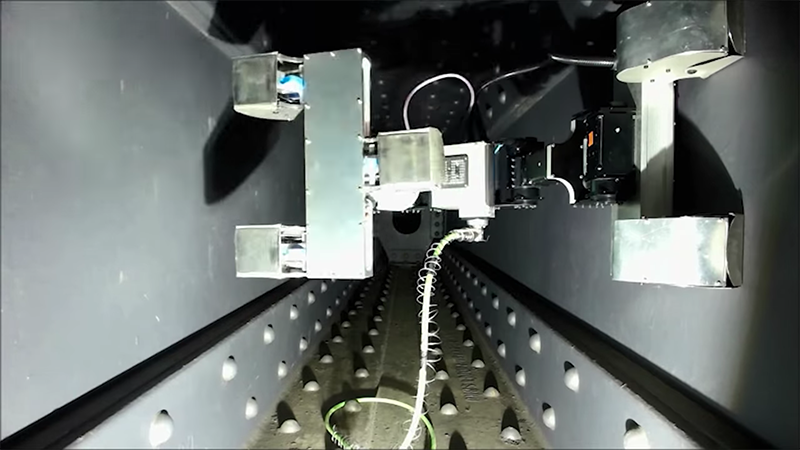It’s an icon of Australia’s architectural and infrastructure history, but the Sydney Harbour Bridge poses a significant OH&S challenge for those tasked with the big job of its maintenance. Enter UTS researchers, and autonomous robots.
Giving robots the dirty work

From exposure to lead-based paint and fine dust particles, to an eye-watering 134-metre drop, workers from the NSW Roads and Maritime Services (RMS) must be up to the task when performing condition assessments and ongoing repairs to the bridge. RMS was keen to address that challenge and approached UTS to help keep workers safe.
Enter Rosie and Sandy, two biologically-inspired inspection robots developed at the UTS Centre for Autonomous Systems (CAS). These robots have been purpose-built to perform condition assessments on the Harbour Bridge and to grit-blast old paint and corrosion in preparation for repainting and repairs. These 25kg smart machines are the first of their kind in the world.
“The job is very risky — the bridge vibrates because of the traffic and it has a complex geography — which is why we approached UTS to see if a machine could do this kind of work,” says RMS planning and delivery manager, Waruna Kaluarachchi.
For CAS director Professor Dikai Liu and his team, the brief was to design robots with a number of key capabilities:
The aim was to develop autonomous robotic systems that could assist in steel bridge maintenance, with the ultimate goal of improving workers’ occupational health and safety.
- Dikai Liu, UTS
“We needed a really light-weight robot but one that also had a high payload (the force used to blast away paint) and that could work on its own in an unfamiliar environment. Such a thing didn’t exist.”

From 2006, Liu and his team collaborated with RMS to develop their first intelligent robot prototypes and test them on the Harbour Bridge. Using sensors to navigate the complex bridge structure, Rosie and Sandy build 3D maps of their surroundings, performing calculations that automatically determine where their grit-blasting machinery should be positioned to achieve the best results. On the robots’ instruction, a human operator presses the “blast” button and the robots start methodically stripping paint from the steelwork.
Shaping the future of global infrastructure maintenance
The results are good – and the potential for market expansion is even better. With more than 270,000 steel bridges in the US, Europe and Japan alone, coupled with a global abrasive blasting market that’s worth $1.2 billion, these purpose-built autonomous systems have huge potential to shape the future of global infrastructure maintenance.
With investment from Sydney-based abrasive blasting equipment company, Burwell, the researchers have commercialised the technology, forming spin-off company Sabre Autonomous Solutions. They are now refining the robots’ unique capabilities for the broader abrasive blasting industry in Australia and overseas, and further developing this advanced technology for applications in other sectors, such as manufacturing, oil and gas.
Liu comments:
“We have a world-first robotic solution — one that operates autonomously even in awkward and complex steel bridge maintenance environments. This robotic technology can be adapted to many other industries including steel fabrication, construction and cleaning.”
The collaboration has received a number of accolades, including:
- Winner of two Engineering Excellence Awards Sydney Division in the Control Systems and Communications, and Research and Development categories.
- Finalist in the Engineers Australia National awards.
- Finalist in the Australia Museum Eureka awards — ANSTO Eureka Prize for Innovative Use of Technology.
- Finalist in the prestigious international Innovation and Entrepreneurship in Robotics and Automation award, organised by the International Federation of Robotics and Institution of Electrical and Electronic Engineers USA (IEEE).
Since the initial project, the research partnership between CAS and the RMS has gone from strength to strength. The team embarked on the development of an intelligent climbing robot that could inspect and assess the condition of the surfaces inside the Harbour Bridge’s arches. After more than 70 successful tests on the bridge, the system is now ready for use.
From above the water to below
Today, the researchers are pressing ahead with the development of an intelligent underwater robot that can inspect and maintain steel structures in near-surface and tidal environments. It’s complex work — these structures are often covered in marine growth, which can make their underlying geometry difficult to see — and it carries a level of risk to human workers that robotics has the potential to solve.
“RMS is committed to innovative solutions as a core value, particularly in regards to safety. Field-deployable robots can allow humans to be removed from a dangerous situation while still getting the maintenance task done,” says Peter Mann, strategic infrastructure manager at RMS.
This successful partnership has delivered results and improved the safety of bridge workers in a practical way. The possibilities are vast, and to that extent, we are pioneering the future in this field.
- Peter Mann, RMS

[music plays]
00:00 [text: Discover]
00:03 [closeup of mens eyes]
00:04 [text: A university]
00:05 [text: where technology]
00:06 [text: drives knowledge]
00:08 [Two men looking up at the Sydney Harbour Bridge]
00:09 [text: with collaborative approaches]
00:11 [Australian flag on the top of the Sydney Harbour Bridge]
00:12 [Robot arm moving towards camera]
00:14 [text: to complex industry problems]
00:15 [Two scientists looking at green chemical tubes]
00:17 [text: sustainable solutions]
00:18 [text: for future industries]
00:19 [Scientist mixing chemicals in large jar]
00:20 [Two people inside analysing data visualisations]
00:23 [text: and deeper insights from data]
00:24 [Two people inside analysing data visualisations]
00:26 [text: Australia’s number 1 university]
00:27 [text: University of Technology Sydney]
Learn more about UTS research and its impact on future work.
Visit entrepreneurship.uts.edu.au and sign up to our Innovation and Entrepreneurship newsletter to discover more future-ready opportunities at UTS.
